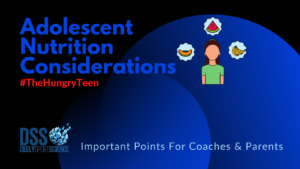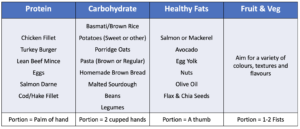
11 Mar Adolescent Nutrition – #TheHungryTeen

The questions is often asked, “What is an appropriate age to introduce young people to resistance training?”. There are a number of factors to be considered when answering this, all of which are outside the scope of this article, but an interest in resistance exercises is often coupled with a heightened awareness of nutrition practices. While various forms of resistance training is new to many adolescents, eating food will not be as it’s something they’ve done their entire lives. Their relationship with food, and the impact it has on their body increases in importance during adolescence as fuel needs increase and adolescents become more aware of their body image. Messaging around food, nutrition and healthy eating also increase during this period and it can be difficult for both adolescents and their parents to identify what is important, what is relevant and how to introduce discussions around food in general. This article will discuss what’s important for adolescents as they progress through the stages of development, how to begin talking about food, what foods to eat and how much of each type.
Adolescent Development & Stage Of Readiness
Types of development:
- Physical Development
- Cognitive Development
- Social-Emotional Development
Before puberty there are minimal differences in terms of height and weight among males and females. As they reach puberty (which females typically reach first) this changes dramatically in terms of size, strength and energy needs. While there are typical age ranges that each change happens, this will differ between individuals so no specific times can be recommended in terms of what age each change or conversation should happen.
Stages Of Development:
- Early Adolescence: Pre-Puberty
Before puberty, children have difficulty thinking about the future, particularly long-term implications of their actions. Explaining that eating a wholegrain piece of bread will be much better than a donut for long term health is difficult to comprehend. The ability to think long-term (and more abstractly) expands as they enter puberty and they can begin to consider some long- and medium term consequences. In terms of social-emotional development, pre-pubescents look to forge an identity for themselves and increase in their desire to “be normal”. This leads to a change in their social influences where friends and peers have far more of an impact and parents less so.
- Middle Adolescence: During Puberty
Girls generally hit puberty 12 months before boys but there will be quite a bit of individual variance. Both males and females will experience major growth spurts, increased perspiration and an increased production of oil in the hair and on the skin. Adolescents will develop a greater capacity for future-oriented and abstract thinking and so develop a greater awareness of long term consequences. This can help with their understanding of how the food they eat now impacts them at a later stage.
- Late Adolescence: Post-Puberty
Boys’ growth spurts will generally last longer than girls’ and may continue right up to age 20. This is an excellent time to develop the valuable skill of delaying instant gratification, by not using food as a reward. Encouraging adolescents to develop the ability to say “no” in the short term in favour of long-term or delayed success is a huge factor in supporting healthy eating habits that stay with them throughout their lives.

Talking About Food
As a secondary school teacher, I recognise how difficult conversations with adolescents can be. The key is not to approach a teenager as if you are approaching another adult, while still not approaching the topic in a condescending or “lecture-style” format. It is too easy to assume an older teenager has a level of maturity that is similar to your own, but no matter how mature they may seem, pushing their emotional and cognitive boundaries may backfire and set the stage for unhealthy habits and thoughts regarding food and themselves. One small tip is to remember that, for the teen, food is fun. This is true in terms of taste, but also true in terms of the social interactions that often surround food and eating.
The best time to begin talking about food with adolescents is to wait until they begin asking. Children have a natural curiosity and will ask lots of questions, largely based around “Why?”. Engaging your adolescent in the preparation of food can set the scene for them to ask questions and gives a “focus” that most questions are likely to be based around. This can help you guide the conversation around specific topics while still giving your adolescent a degree of control or autonomy.

It is also important to choose your words wisely and plan some responses out in advance. Loaded word choices and labels such as “bad” or “you should never…” can lead to black and white thinking around food and potentially cause poor relationships with specific foods alter in life.

Fuelling The Adolescent & Consequences Of Long-Term Energy Restriction
Total energy needs (calories) are highest during adolescence compared to any other time in life. Growth rates are also quite high which places further energy demands on the body. Nutrient needs and physical growth are tightly intertwined: as an adolescent grows, his or her energy needs also need to increase. Meeting their individual needs is essential for the achievement of optimal growth and development, and failure to do so can inhibit physical and cognitive development, not to mention sport performance. In simple terms, adolescents require fuel round the clock. It’s perfectly “normal” for them to be hungry an hour or two after a meal, and an hour or two after that, particularly during peak growth phases.
Protein Needs
Protein intake is important for the maintenance of existing lean body mass and any increases that happen when growing. Protein requirements are highest for females aged 11 to 14 and males aged 15 to 18. The majority will need 1 to 1.5 g/kg of protein to ensure they growing adequately.
Carbohydrate Needs
There are no definitive guidelines on carbohydrate intake for adolescents as needs vary wildly based on activity levels. A rough guideline is to aim for 50% of total calories to be supplied by carbohydrates. When choosing carbohydrates, the majority should come from high-fibre, nutrient dense options such as fruit, whole-grains, potatoes and rice.
Fat Needs
Again, there are no specific recommendations for fat intake but a general guideline of less than 30% of total calories with less than 10% from saturated fat is okay.
Micronutrients
While all micronutrients serve specific needs in the diet, some will be of more importance to adolescents than others. These include
- Calcium – bone formation and growth
- Vitamin D – Absorption of other micronutrients
- Iron – Transport of oxygen to where it’s required in the body
- Zinc – Growth and development, and immune function
- B-Vitamins – Harvest energy from the foods that you do eat
Impact Of Long-Term Calorie Restriction (Under-Eating)
Increased activity levels and growth lead to very high energy demands. Although many adolescents seem like they’re constantly eating it’s rare to see an active teen put on excess weight. It’s important to monitor an adolescents’ energy levels, mood, fatigue and physical appearance in case they are in a state of energy restriction over a prolonged period. Some of the consequences of long-term under-eating are outlined below:
- Stunted growth
- Delayed onset of puberty
- Menstrual irregularities
- Poor bone health
- Vitamin and mineral deficiencies (and the specific negative consequences for each)
- Increased risk of injury
- Increased risk of disordered eating
Building The Ultimate Plate
This section will look at how to put together some meals that meet the majority of adolescents nutrient needs while not compromising on taste or enjoyment.
The four key factors that should be included on each plate are:
- Lean Protein Source
- Quality Carbohydrate
- Fruits & Vegetables
- Healthy Fat

Example Meals
- Lean Beef Burger, Wholegrain Bap, Lettuce & Tomato, Roast Maris Pipers
- Grilled Salmon, Steamed Mixed Vegetables, Boiled Basmati Rice
- 3 Egg Omelette, Spinach, Tomato, Homemade Brown Bread
- Pasta, Tomato Sauce, Chicken, Mixed Peas & Sweetcorn
- Porridge Oats, 0% Greek Yoghurt, Mixed Berries, Chia Seeds, Water or Low-Fat Milk
Summary
Overall, it’s important to be aware of an adolescents’ energy and nutrient needs but counting calories certainly isn’t necessary. Monitoring energy, mood, fatigue and general appearance is usually enough to ensure teens are adequately fuelled. Having open conversations about food, especially in terms of their specific likes and dislikes are key to finding out what works and doesn’t for each individual. Constantly being hungry or eating isn’t a sign of anything being wrong but is a sign that energy needs are quite a bit higher. While adolescents can “get away with” eating more “junk food” due to their increased energy burn, it’s still important to build a foundation of healthy eating based on the options above before adding potential treats on top. Try to feed curiosity about food and nutrition with open questions and options where they can source further information at a level they’re able to understand. It’s also important to include adolescents in the preparation of food both for the development of their cooking (which is an important like-skill) but also to appreciate the effort that goes into preparing all of the food they have been eating over the last 12-18 years.
If you’ve any questions on the above or would like further information then feel free to contact met at @fhspeformance on Twitter or Instagram.



No Comments